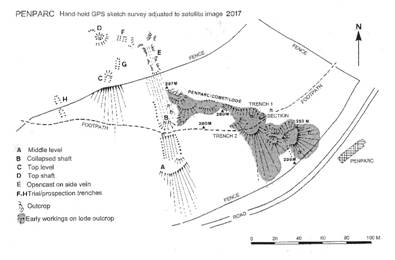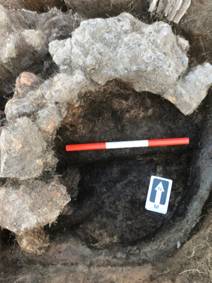|
|
|
||||||
| Home/Adref | Cwmystwyth | Portfolio | Links/ Dolenni | ||||
Pre- Industrial Archaeology of Cwmystwyth
Cwmystwyth is arguably one of the most important early mining sites in Europe Most archaeological work at Cwmystwyth has been undertaken by the Early Mines Research Group (EMRG) - a small specialist group of mining archaeologists who have worked for more than 30 years looking for the evidence of early mining activity in Britain, particularly in Wales. These investigations began at Cwmystwyth in 1987, with Simon Timberlake (current Cambrian Mines Trust director) examining the ancient mine tips associated with the Comet Lode Opencast, on the brow of Copa Hill, at the far eastern end of the mine (grid reference SN 811752 approx. 426m AOD). Suspicions about the antiquity of this site led to the scheduling of the mine in 1985, the area in question subsequently being extended to include most of the known historic workings.
Left: Map showing location of Comet Lode Opencast (Copa Hill) and smelting site. A Bronze Age mine Archaeological excavations carried out within the Comet Lode opencast during the 1990s uncovered evidence of an undisturbed copper mine of the Early Bronze Age; One of the first metal mines in Britain to have been worked during the period c 2100-1650 BC. The 8m deep excavations revealed a series of opencut workings dug upon a branched stockwork of veins carrying chalcopyrite (copper iron sulphide) within a breccia of iron carbonate and quartz associated with galena (lead sulphide). Lying beneath metres of peat upon the ancient working floor of the mine were found numerous tools made of wood and antler alongside some examples of primitive mining equipment, including several sections of hollowed-out alder and oak tree-trunk launders which had been cut and placed to carry water out from the mine, and potentially also for the purposes of washing and separating the lead from the oxidised copper ores they were seeking. Amongst the sediments and mine waste were found thousands of stone mining tools, many of them surviving here just as broken and sometimes re-used fragments. Oak and hazel firewood was recovered which had been used to crack and soften the rock (fire setting), and there was evidence too of mineral processing – most of it perhaps to obtain a concentrate which could be taken away and smelted elsewhere. Just over 5000 tons of rock seems to have been removed from the mine, from which a small amount of copper was probably recovered (this may have been as little as 4-10 tons of metal –but still a lot in terms of the number of axes or other objects which might have been made from this). We are currently trying to recognize metal mined from this source (and from other similar mines in the Cambrian Mountains of mid-Wales) within contemporary Bronze Age metalwork.
|
|||||||
|
|
|||||||
|
Above:Comet
Lode Opencast with prehistoric tips containing hundreds of stone
mining tools
|
Above: Fireset and stone tool-worked roof of a small gallery excavated within the Bronze Age Opencast | ||||||
  Left: Removal of the overlying peat layers accumulated over
2-3000 years reveals the ledges, rock channels and floors of the ancient
mine. Left: Removal of the overlying peat layers accumulated over
2-3000 years reveals the ledges, rock channels and floors of the ancient
mine.
Right: Hazel withy used as part of a basket handle – found within the waterlogged layers of the mine.
|
|||||||
|
|
|||||||
|
Right: Wooden launder mad out of a split and hollowed-out alder log – found in position upon the working floor of the mine. |
|||||||
|
Roman and medieval lead smelting By examining the palaeo-pollution record preserved within the blanket bog above the mine we have been able to identify this Bronze Age mining period – one which all but ceased around 1650 BC when the mine became flooded and exhausted of the more easily-won ore. However, lead mining and smelting at this end of the Cwmystwyth valley revived during the Roman period (late 1st-2nd century AD) and again during the Early Medieval period up to the period of the dissolution of the nearby Strata Florida (Cistercian) Abbey. Roman and medieval lead smelting furnaces have been found in the valley bottom near Banc Tynddol. Some of these, alongside the charcoal production excavated by the EMRG. |
|||||||
 
|
|||||||
| Above Left: Roman pit bole (wind draught) furnace, Banc Tynddol. Above:: The two halves of the stone mace head, placed together. | |||||||
|
Prehistoric finds Yet other important finds made within the vicinity of Copa Hill include that of the small Beaker gold foil disc found in 2002. The latter may have been made around 4000-4500 years ago, and is quite likely to have something to do with the start of mining here. No settlement has been found nearby, but a prehistoric monument was discovered upon the plateau of Pant Morcell just to the east of the Graig Fawr. This site is overlooked by the Bronze Age mine, and may be contemporary or earlier in date. This originally had a circle of small standing stones around the kerb of a very low-lying (now denuded) cairn. This was excavated by the EMRG in 2016, and some interesting finds (including two halves of an intentionally split stone macehead) were found.
|
|||||||
 
|
|||||||
|
Above Left:: The Beaker gold disc found close to the mine site (image NMGW) Above::The stunning location of the Pant Morcell kerb circle
|
|||||||
  |
|||||||
| Above Left: Roman pit bole (wind draught) furnace, Banc Tynddol. Above: reconstruction of a medieval bole similar to one excavated nearby. | |||||||
|
A second Bronze Age mine In 2017 a second Bronze Age mine was identified on the north side of the Ystwyth valley at a location above Penparc(at SN 7955 7406 between 250-300m AOD), approximately 2 kilometres west of the Comet Lode Opencast on Copa Hill. Hammerstones from here were first noticed by David James in 2015, and these subsequently identified as prehistoric mining tools. The site was surveyed and evaluation trenches dug for dating and sampling purposes. The two published radiocarbon dates confirmed that this mine was being worked around the same time as the openwork on Copa Hill, but was ‘relatively late’ in the sequence. Although no actual copper minerals were identified in the mine spoil, the copper concentrations were high, and it seems here that they were working below a gossan in the top of the vein. The Penparc Lode is the westerly offset of the Comet Lode displaced here by the downthrow of the Ystwyth Fault. Work continues on this new discovery.
|
|||||||
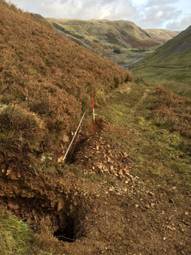
|
|||||||
|
Above Left: The infilled prehistoric workings where these cross the bridle path above Penparc. Copa Hill can be seen in the background. Above Right:A survey of the area of early workings. Not far above the fence line these are cut off by the Ystwyth Fault.
|
|||||||
|
Medieval iron smelting Between 2020 and 2022 the group examined another area of the valley floor at Cwmystwyth, this time located a short distance below the second Bronze Age mine to have been discovered in the valley at Penparc (Comet Lode West). Guided by a geophysical survey undertaken by TigerGeo Ltd we managed to locate a further charcoal clamp dating to the Late Iron Age – Early Roman period, and beyond this an ironworking site. The latter revealed evidence for smithing as well as smelting, yet it was dominated by the waste from a tap-slagging furnace. Excavations carried out in 2022 revealed a considerable amount (in excess of 250 kg) of bloomery iron smelting slag associated with a slag dump, a well-preserved slag pit and working floor, a tap channel and part of the base of a circular shaft furnace of about 300mm internal diameter. This had heavily vitrified clay walls, as shown by the fragments preserved within the base of the shaft pit, just below the tuyere (air inlet) level. Hand bellows would have been used to fire this furnace on its western side, possibly via a single tuyere; the only trace of this which remains is the opening for this which survives within one of the collapsed wall fragments. A series of stake holes and an area of trod probably defines the area of the bellows. The source of the iron ore is unknown. In all likelihood this was a bog iron or iron pan dug from the mountain peat mire or valley floor, although possibly it was an iron gossan or carbonate (mineral) removed from the nearby Comet Lode. An Early Medieval date for these furnaces is suggested by the dating of charcoal trapped within a piece of tap slag. The radiocarbon date of 1047 – 1256 cal AD would appear to link this site (and those for lead smelting less than a kilometre to the east) with the interests of the Cistercians at the nearby Strata Florida Abbey, who it is recorded had control of these mines and the natural resources within this valley. We know for instance that the abbey was constructed in 1164 AD and then re-built in 1201 AD, for which purpose iron and lead would have been required in large amounts.
|
|||||||
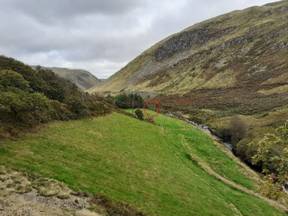 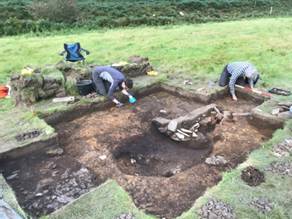
|
|||||||
| Above Left:: The valley looking east towards the site (see red circle). Above Right:: The furnace and slag pit under excavation. | |||||||
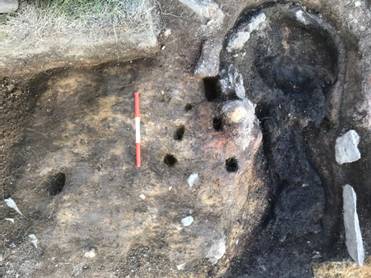
|
|||||||
|
Above left:: Furnace, stakeholes for shield and hand bellows and channel with tap slag. Above: Shaft furnace with remains of vitrified wall |
|||||||
|
An 18th century lead stamping mill Thomas Bonsall’s stamp mill located on Copa Hill (Kingside workings) close to the Nant yr onnen stream and Herbert’s stope was excavated by the group in March 2007. This revealed the foundations of a late 18th century- early19th century water-driven wet stamping mill used for processing relatively poor-grade hard lead ores associated with quartz. The resulting lead concentrate which settled out within a wooden barrel located below an iron grate was then hand-jigged and the waste from it likewise buddled to recover the most finely crushed lead. A flow of water would once have been diverted from the overshot waterwheel and its velocity controlled sufficiently to wash away the lighter crushed quartz and rock. These wet stamping mills were thought novel at the time, and this one was modelled on Bonsall’s stamp mill at Ashover in Derbyshire. We found a miner’s sock that had once been used to mend a hole in the wooden launder. Beneath the later mill foundations was possible evidence for an earlier one, alongside fragments of 17th century pottery. Thus this site may also be the location of William Waller’s stamp mill which had been portrayed, somewhat stylistically, in his account of the Company of Mine Adventurer’s earlier workings in this area of the mine.
|
|||||||
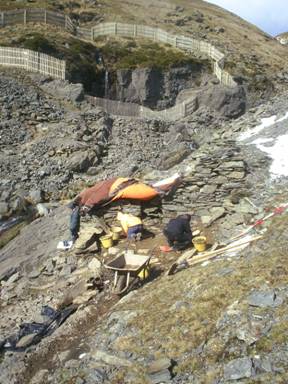 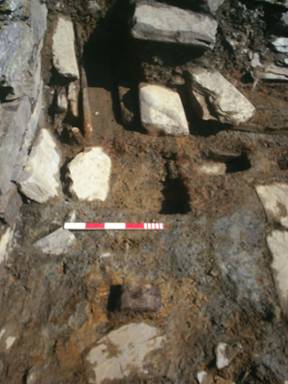 |
|||||||
|
Above Left:: Bonsall’s Stamp Mill with Herbert’s Stope in background. Above::Floor detail showing launder below the level of stamps grate.
|
|||||||
|
More details of work carried out here and elsewhere in
mid-Wales can be found on the Early Mines Research Group website:
Early Mines
Research Group Copyright Simon Timberlake 2025
|
|||||||





